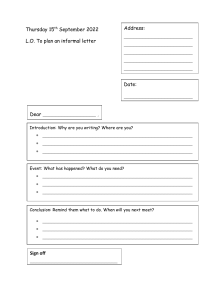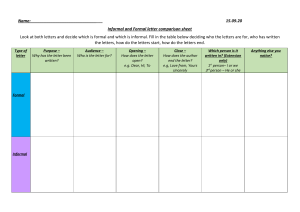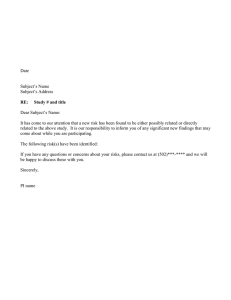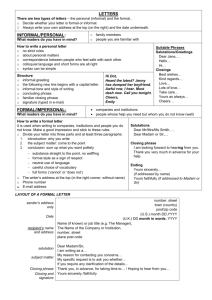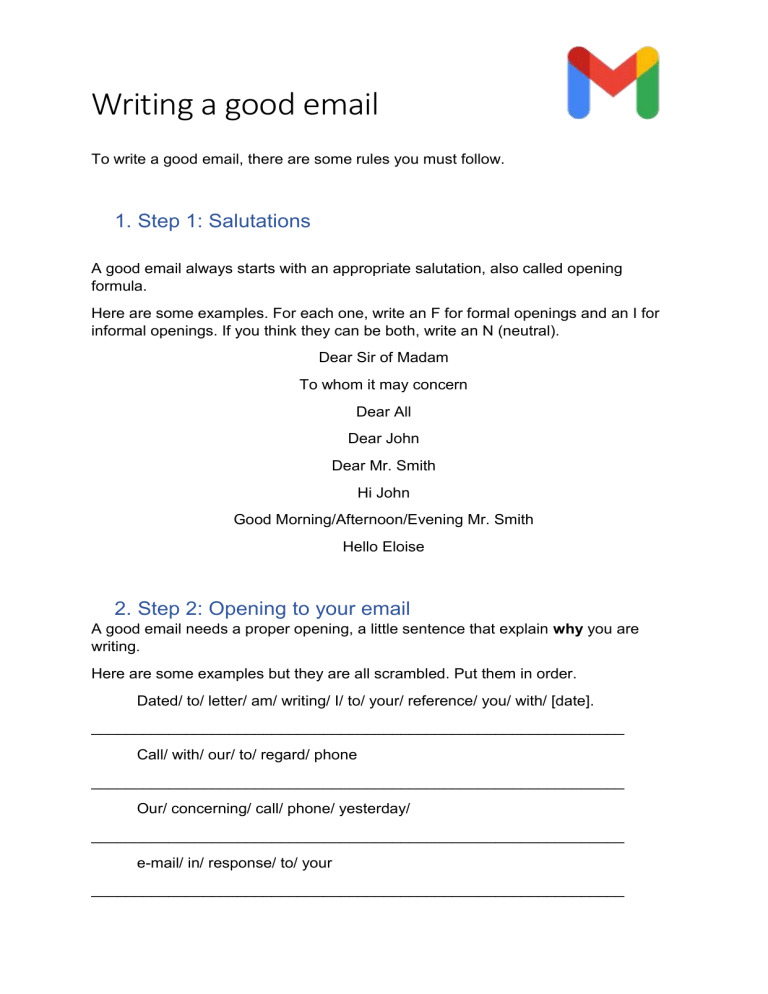
Writing a good email To write a good email, there are some rules you must follow. 1. Step 1: Salutations A good email always starts with an appropriate salutation, also called opening formula. Here are some examples. For each one, write an F for formal openings and an I for informal openings. If you think they can be both, write an N (neutral). Dear Sir of Madam To whom it may concern Dear All Dear John Dear Mr. Smith Hi John Good Morning/Afternoon/Evening Mr. Smith Hello Eloise 2. Step 2: Opening to your email A good email needs a proper opening, a little sentence that explain why you are writing. Here are some examples but they are all scrambled. Put them in order. Dated/ to/ letter/ am/ writing/ I/ to/ your/ reference/ you/ with/ [date]. ______________________________________________________________ Call/ with/ our/ to/ regard/ phone ______________________________________________________________ Our/ concerning/ call/ phone/ yesterday/ ______________________________________________________________ e-mail/ in/ response/ to/ your ______________________________________________________________ your/ considering/ quote ______________________________________________________________ Week/ I/ the/ a/ start/ hope/ had/ great/ you/ to ______________________________________________________________ Trust/ fine/ I/ doing/ you’re ______________________________________________________________ Hope/ well/ you/ finds/ I/ email/ this ______________________________________________________________ 3. Step 3: Asking for information Sometimes, you might need to ask politely for information. Here are some examples. For each, complete the sentence with an example of what you could ask. Some are more informal than others, find them. Please inform me as to when you would be available to do the work. Can you give me an update… Let me have your most competitive quote… Please help me understand… Can we ask you … What is the latest development in… I’m reaching out about… I’m getting back to you about… This is a follow up from… As discussed in the foregoing discussion… 4. Step 4: Suggestions Sometimes, the aim of your email is to offer something, a change date, a change of venue, an offer for a new product,etc. Here are some examples. I would like to offer you… We would like to interest you in… Could we interest you in… ? We hereby send you … We would like to suggest our most competitive offer… We must suggest a change of venue… We will have to ask to postpone our appointment… 5. Step 5: Agreeing and disagreeing In your email, you can acknowledge your correspondent’s opinion by agreeing with them or disagreeing with them. Here are some examples. For each of them, write an A when it signifies agreement and D for disagreement. I am afraid I cannot agree with you. I could not agree with you more. I could not agree with you less. I agree You have hit the nail on the head. We are sorry to inform you… We are sad to say that we cannot participate in… We are happy to inform you… Our thoughts are parallel. I disagree We are of one mind. We see eye to eye. 6. Step 6: Closing A good email always ends with a closing formula. Sometimes you might need to write more just to sound more polite and other times, you’ll be very brief. One way or the other, you need to end your email correctly. Here are some examples. For each of them, write an F (formal), an I (informal) or a B (both). Looking forward to hearing from you soon. Thanks in advance. I appreciate your (help, feedback, input). Cheers. Best regards. Yours truly. (Yours) Sincerely. Best Wishes. Best, Sending you positive vibes, 7. Let’s recap’! There are 5 big steps to follow when writing an email: 1. Salutation 2. Opening sentence 3. Body of the email (steps 3, 4 and 5) 4. Closing sentence 5. Signature To better understand, take a look at the following email and identify the parts.
